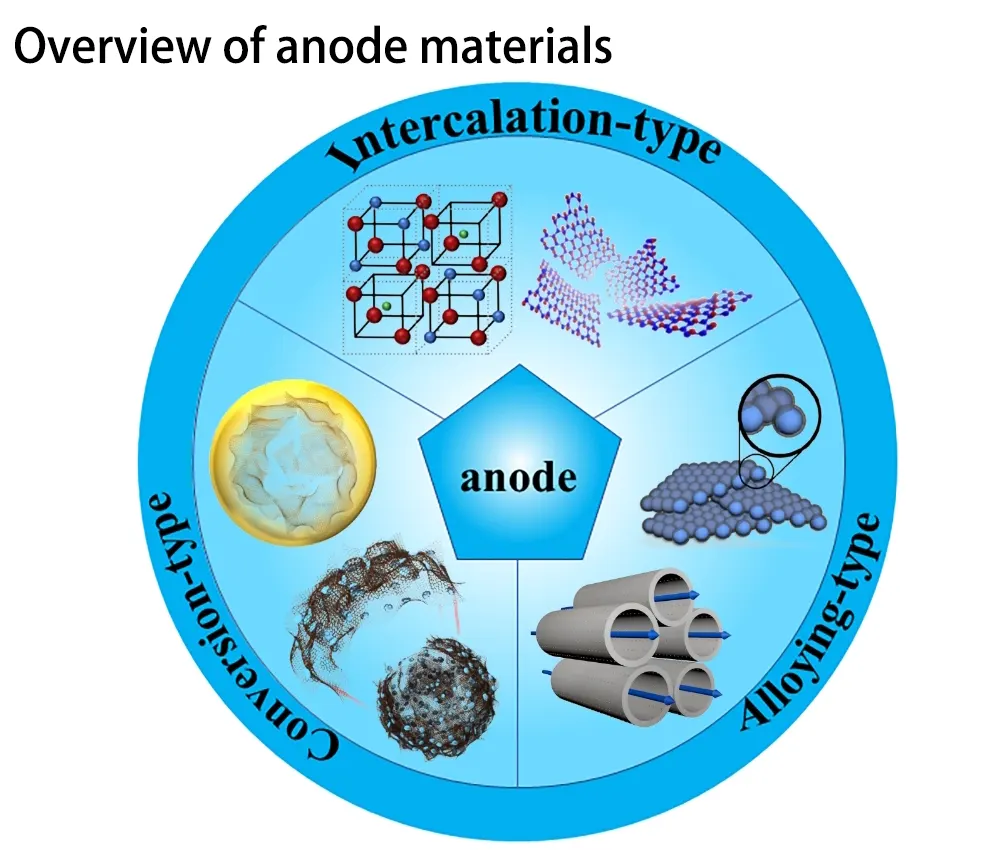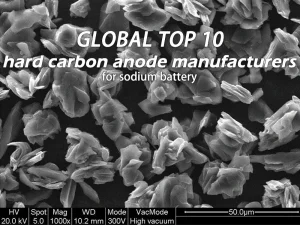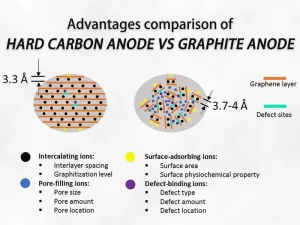Performance characteristics and solution analysis of silicon anode
With the development of society and technology, in order to meet the needs of multi-functional products, people have put forward higher and higher requirements for the battery life, safety and fast charging performance of lithium-ion batteries. Electrode materials are the core elements that determine the performance of lithium-ion batteries, and are also the main components that affect costs.
The development of active materials with higher gram capacity is one of the main directions for improving the energy density of lithium batteries. Among all anode materials, silicon anode has the highest theoretical gram capacity, abundant reserves, low price, and great research and application potential. It is one of the research focuses of major lithium battery material factories such as the China top 10 anode material manufacturers and battery factories in recent years.

Overview of anode materials
Lithium battery anode materials are mainly divided into carbon-based materials and non-carbon-based materials. Carbon-based materials include natural graphite anodes, artificial graphite anodes, mesocarbon microspheres (MCMB), soft carbon anode, hard carbon anode, carbon nanotubes, graphene, carbon fibers, etc. Non-carbon-based materials are mainly divided into silicon-based and its composite materials, nitride anode, tin-based materials, lithium titanate, alloy materials, etc.
At present, the commercial anode material is mainly graphite, and the theoretical specific capacity of graphite anode in lithium battery is only 372mAh/g. The actual specific capacity of commercial high-end graphite materials is already 360-365 mAh/g, which is very close to its theoretical specific capacity. Improving and perfecting graphite anode materials has very limited improvement in the energy density of lithium-ion batteries.
Silicon anode is considered to be one of the most promising anodes for lithium-ion batteries. The theoretical specific capacity of single Si at room temperature is as high as 3579mAh/g, which is a kind of anode material for lithium-ion batteries with extremely high theoretical specific capacity.
Structure and performance characteristics of silicon anode materials
The raw material of silicon anode is mainly composed of silicon material and graphite. Silicon has outstanding advantages as the negative electrode material of lithium ion battery.
- First of all, the silicon anode is alloyed with lithium at room temperature, and the theoretical specific capacity is as high as 4200mAh/g, which is more than ten times that of the current graphite anode materials;
- Secondly, compared with graphite, silicon is abundant in the crust and widely distributed, accounting for 25.8% of the mass of the crust, and is the second most abundant element in the crust;
- Third, the silicon anode has a slightly higher potential platform (about 0.4 V, Li/Li+) than graphite, so there is no hidden danger of lithium precipitation and good safety;
- Fourth, the low temperature performance of silicon anode material is better than that of graphite;
- Fifth, it can provide channels for lithium ion intercalation and extraction from all directions, and has excellent fast charging performance. Silicon anode is expected to be an ideal substitute for graphite anode.
However, there are great challenges in the application of silicon anodes as anode materials for lithium-ion batteries. The following shortcomings severely restrict its industrial application:
- The volume expansion and contraction of the silicon anode during the process of lithium intercalation and deintercalation can be as high as 300%, which in turn generates a huge mechanical stress. After many cycles, the silicon particles will be broken and pulverized, which will seriously hinder the transmission of lithium ions inside the anode, resulting in low initial efficiency and poor cycle performance;
- During the charge and discharge process, silicon particles rupture, and the poor electrical contact between the active particles and the current collector forms an “island effect”, and new SEI films are repeatedly formed on the fracture surface, resulting in irreversible capacity loss and low Coulombic efficiency;
- Silicon is a semiconductor with low conductivity and ion diffusion coefficient, resulting in a decrease in the kinetics of lithium ion diffusion;
- The nanostructure effect will cause problems such as large specific surface area and low tap density;
- It is necessary to develop new electrolyte systems and bonding systems to meet the application process requirements of materials.
Comparison of silicon anode vs natural graphite anode vs artificial graphite anode
| Types | Natural graphite | Artificial graphite anode | Silicon anode |
|---|---|---|---|
| Theoretical capacity | 340-370mAh/g | 310-360mAh/g | 400-4000mAh/g |
| First efficiency | >93% | >93% | >77% |
| Cycle life | General | Better | Poor |
| Rate performance | General | General | Better |
| Cost | Lower | Lower | Higher |
| Pros | High energy density, good processing performance | Low expansion, good cycle performance | High energy density |
| Cons | Electrolyte has poor compatibility and large expansion | Low energy density and poor processing performance | Large expansion, low initial efficiency, poor cycle performance |
The solution to the problem of silicon anode
Due to the inherent defects of silicon anode materials, the material level needs comprehensive treatment such as nanonization and carbon coating, and the process is complicated. At present, only a few companies in the industry have mastered it, and each process is different. At present, there is no standardized process.
From the perspective of the process route, the current silicon anode is divided into two technical routes: silicon carbon anode and silicon oxygen anode. The current commercial application capacity of silicon carbon anode materials of top 10 silicon-carbon anode material manufacturers is below 450mAh/g, which is mainly used in the 3C digital field. The current commercial application capacity of silicon-oxygen anode materials is mainly 450-500mAh/g, which is mainly used in the field of power batteries.
Silicon carbon anode vs silicon oxide anode
| Classification | Pros | Cons |
|---|---|---|
| Silicon carbon anode | Lower cost; The first charge and discharge efficiency is high; High gram capacity; The technology is more mature | It is difficult to mass produce products with excellent performance; Poor cycle performance and low Coulombic efficiency; High electrode expansion rate |
| Silicon oxide anode | Good cycle performance and good rate performance; Small expansion and wide application range; The reversible capacity is as high as 1700-1800mAh/g, close to the theoretical capacity | Higher cost; The first coulombic efficiency is low, it cannot be used alone, and pre-lithiation treatment is required |
Silicon carbon anode solution
Whether it is silicon carbon or silicon oxygen, there are still some problems to be solved in industrialization. From the solution point of view, the problem of the expansion rate of silicon carbon is generally solved by the carbon coating technology of nano-silicon, and the silicon-oxygen anode improves the first effect by pre-magnesium or pre-lithium. Carbon-coated nano-silicon is a structure in which nano-silicon is used as a raw material and the surface is coated with a carbon layer.
The size of silicon anode particles is the key. The larger the particle size, the lower the cost, but the cycle performance may be poor. The volume expansion of large-sized silicon anode particles will lead to internal cracking of the composite material, destroying the continuity of electron conduction and reducing performance.
Theoretically speaking, the smaller the silicon grains, the better the cycle performance. The preparation of nano-silicon is divided into different technical routes, including grinding or vapor deposition, and vapor deposition is divided into PVD and CVD.
Silicon oxide anode solution
The silicon-oxygen composite material is based on the silicon oxide material as the core. The silicon oxide here is generally uniformly distributed in the SiO2 matrix with 2-10nm silicon-carbon particles by chemical vapor deposition. Its monomer capacity is generally 1300-1700 mA h/g.
Compared with silicon carbon, the biggest disadvantage of silicon oxide is that the first effect is lower, and the first effect needs to be improved by pre-magnesium or pre-lithium process. Pre-magnesium is the middle route to solve the first effect, and the cost performance is relatively high.
Commercialization progress of silicon anode
At this stage, the commercialization of silicon anode materials mainly includes: carbon-coated silicon oxide, nano-silicon carbon, silicon nanowires, and amorphous silicon alloys. Among them, carbon-coated silicon oxide and nano-silicon carbon are the most commercialized, and they are all doped in graphite according to a certain proportion (5%-10%).
In recent years, silicon anode has gradually moved towards industrial production, but the industrialization time is relatively short, and there are relatively few companies capable of mass production.
At present, commercialized silicon anodes are mainly used in the field of electric vehicles and electric tools, and in the past two years, they have gradually formed an application trend in wearable and consumer digital products. Panasonic, Samsung, CATL and other battery factories have partially adopted related products such as BTR or Shanshan and other China top 10 anode material manufacturers, and the application of silicon anode in some models such as Tesla has also been implemented.
CATL, Lishen, GOTION HIGH-TECH, BYD and other top 10 lithium ion battery manufacturers are accelerating the research and development and trial production of silicon anode batteries.
In the future, with the mass production of 4680 large cylindrical batteries, the silicon anode market space will be opened. It is expected to be applied to other power batteries after 2023, especially in high-nickel fields. Coupled with the increase in the penetration rate of consumer batteries, it is estimated that the global silicon-based anode market space may reach 30 billion RMB in 2025.






















